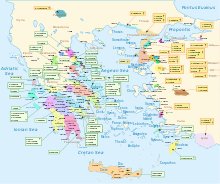Mycenaean Greek language
| Mycenaean Greek | |
|---|---|
| Region | southern Balkans/Crete |
| Era | 16th–12th century BC |
| Linear B | |
| Language codes | |
| ISO 639-3 | |
|
Linguist list
|
gmy |
| Glottolog | myce1241 |

Map of Greece as described in Homer's Iliad. The geographical data is believed to refer primarily to Bronze Age Greece, when Mycenaean Greek would have been spoken and so can be used as an estimator of the range.
|
|
Mycenaean Greek is the most ancient attested form of the Greek language, on the Greek mainland, Crete and Cyprus in Mycenaean Greece (16th to 12th centuries BCE), before the hypothesised Dorian invasion, often cited as the terminus post quem for the coming of the Greek language to Greece. The language is preserved in inscriptions in Linear B, a script first attested on Crete before the 14th century. Most inscriptions are on clay tablets found in Knossos, in central Crete, as well as in Pylos, in the southwest of the Peloponnese. Other tablets have been found at Mycenae itself, Tiryns and Thebes and at Chania, in Western Crete. The language is named after Mycenae, one of the major centres of Mycenaean Greece.
The tablets long remained undeciphered, and many languages were suggested for them, until Michael Ventris deciphered the script in 1952.
The texts on the tablets are mostly lists and inventories. No prose narrative survives, much less myth or poetry. Still, much may be glimpsed from these records about the people who produced them and about Mycenaean Greece, the period before the so-called Greek Dark Ages.
The Mycenaean language is preserved in Linear B writing, which consists of about 200 syllabic signs and logograms. Since Linear B was derived from Linear A, the script of an undeciphered Minoan language probably unrelated to Greek, it does not reflect fully the phonetics of Mycenaean. In essence, a limited number of syllabic signs must represent a much greater number of produced syllables, better represented phonetically by the letters of an alphabet.
...
Wikipedia
